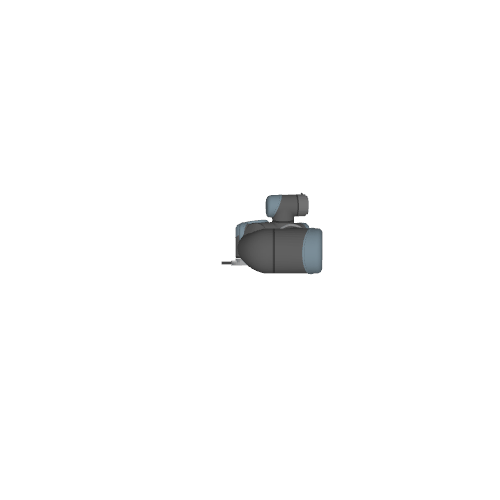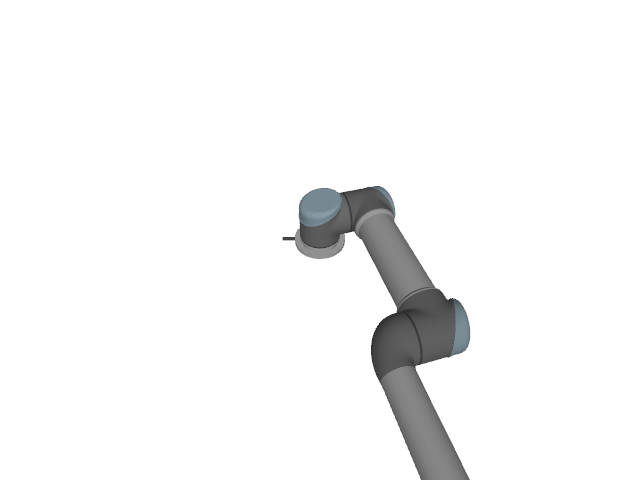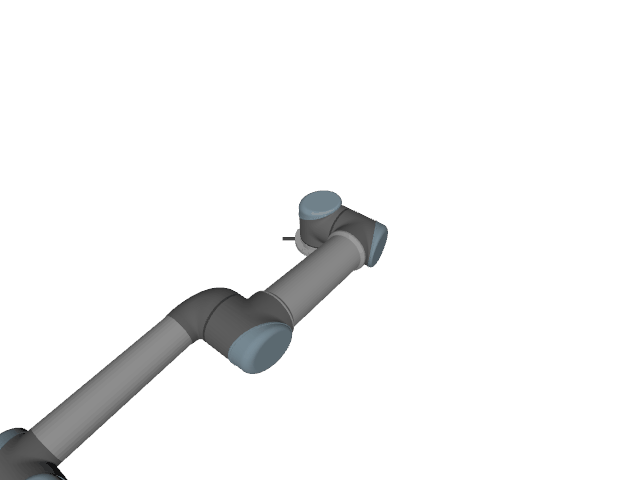URDF¶
-
class
urdfpy.URDF(name, links, joints=None, transmissions=None, materials=None, other_xml=None)[source]¶ Bases:
urdfpy.URDFTypeThe top-level URDF specification.
The URDF encapsulates an articulated object, such as a robot or a gripper. It is made of links and joints that tie them together and define their relative motions.
Parameters: - name (str) – The name of the URDF.
- links (list of
Link) – The links of the URDF. - joints (list of
Joint, optional) – The joints of the URDF. - transmissions (list of
Transmission, optional) – The transmissions of the URDF. - materials (list of
Material, optional) – The materials for the URDF. - other_xml (str, optional) – A string containing any extra XML for extensions.
Attributes Summary
actuated_jointsThe joints that are independently actuated. base_linkThe base link for the URDF. end_linksThe end links for the URDF. joint_limit_cfgsThe lower-bound and upper-bound joint configuration maps. joint_mapMap from joint names to the joints themselves. jointsThe links of the URDF. link_mapMap from link names to the links themselves. linksThe links of the URDF. material_mapMap from material names to the materials themselves. materialsThe materials of the URDF. nameThe name of the URDF. other_xmlAny extra XML that belongs with the URDF. transmission_mapMap from transmission names to the transmissions themselves. transmissionsThe transmissions of the URDF. Methods Summary
animate([cfg_trajectory, loop_time, …])Animate the URDF through a configuration trajectory. collision_geometry_fk([cfg, links])Computes the poses of the URDF’s collision geometries using fk. collision_trimesh_fk([cfg, links])Computes the poses of the URDF’s collision trimeshes using fk. link_fk([cfg, links])Computes the poses of the URDF’s links via forward kinematics. load(file_obj)Load a URDF from a file. save(file_obj)Save this URDF to a file. show([cfg, use_collision])Visualize the URDF in a given configuration. visual_geometry_fk([cfg, links])Computes the poses of the URDF’s visual geometries using fk. visual_trimesh_fk([cfg, links])Computes the poses of the URDF’s visual trimeshes using fk. Attributes Documentation
-
actuated_joints¶ The joints that are independently actuated.
This excludes mimic joints and fixed joints.
Type: list of Joint
-
base_link¶ The base link for the URDF.
The base link is the single link that has no parent.
Type: Link
-
end_links¶ The end links for the URDF.
The end links are the links that have no children.
Type: list of Link
-
joint_limit_cfgs¶ The lower-bound and upper-bound joint configuration maps.
The first map is the lower-bound map, which maps limited joints to their lower joint limits. The second map is the upper-bound map, which maps limited joints to their upper joint limits.
Type: tuple of dict
-
joint_map¶ Map from joint names to the joints themselves.
This returns a copy of the joint map which cannot be edited directly. If you want to add or remove joints, use the appropriate functions.
Type: dict
-
joints¶ The links of the URDF.
This returns a copy of the joints array which cannot be edited directly. If you want to add or remove joints, use the appropriate functions.
Type: list of Joint
-
link_map¶ Map from link names to the links themselves.
This returns a copy of the link map which cannot be edited directly. If you want to add or remove links, use the appropriate functions.
Type: dict
-
links¶ The links of the URDF.
This returns a copy of the links array which cannot be edited directly. If you want to add or remove links, use the appropriate functions.
Type: list of Link
-
material_map¶ Map from material names to the materials themselves.
This returns a copy of the material map which cannot be edited directly. If you want to add or remove materials, use the appropriate functions.
Type: dict
-
materials¶ The materials of the URDF.
This returns a copy of the materials array which cannot be edited directly. If you want to add or remove materials, use the appropriate functions.
Type: list of Material
-
transmission_map¶ Map from transmission names to the transmissions themselves.
This returns a copy of the transmission map which cannot be edited directly. If you want to add or remove transmissions, use the appropriate functions.
Type: dict
-
transmissions¶ The transmissions of the URDF.
This returns a copy of the transmissions array which cannot be edited directly. If you want to add or remove transmissions, use the appropriate functions.
Type: list of Transmission
Methods Documentation
-
animate(cfg_trajectory=None, loop_time=3.0, use_collision=False)[source]¶ Animate the URDF through a configuration trajectory.
Parameters: - cfg_trajectory (dict) – A map from joints or joint names to lists of configuration values for each joint along the trajectory. If not specified, all joints will articulate from limit to limit. The trajectory steps are assumed to be equally spaced out in time.
- loop_time (float) – The time to loop the animation for, in seconds. The trajectory will play fowards and backwards during this time, ending at the inital configuration.
- use_collision (bool) – If True, the collision geometry is visualized instead of the visual geometry.
Examples
You can run this without specifying a
cfg_trajectoryto view the full articulation of the URDF>>> robot = URDF.load('ur5.urdf') >>> robot.animate()

>>> ct = {'shoulder_pan_joint': [0.0, 2 * np.pi]} >>> robot.animate(cfg_trajectory=ct)

>>> ct = { ... 'shoulder_pan_joint' : [-np.pi / 4, np.pi / 4], ... 'shoulder_lift_joint' : [0.0, -np.pi / 2.0], ... 'elbow_joint' : [0.0, np.pi / 2.0] ... } >>> robot.animate(cfg_trajectory=ct)

-
collision_geometry_fk(cfg=None, links=None)[source]¶ Computes the poses of the URDF’s collision geometries using fk.
Parameters: - cfg (dict) – A map from joints or joint names to configuration values for each joint. If not specified, all joints are assumed to be in their default configurations.
- links (list of str or list of
Link) – The links or names of links to perform forward kinematics on. Only geometries from these links will be in the returned map. If not specified, all links are returned.
Returns: fk – A map from
Geometryobjects that are part of the collision elements of the specified links to the 4x4 homogenous transform matrices that position them relative to the base link’s frame.Return type:
-
collision_trimesh_fk(cfg=None, links=None)[source]¶ Computes the poses of the URDF’s collision trimeshes using fk.
Parameters: - cfg (dict) – A map from joints or joint names to configuration values for each joint. If not specified, all joints are assumed to be in their default configurations.
- links (list of str or list of
Link) – The links or names of links to perform forward kinematics on. Only trimeshes from these links will be in the returned map. If not specified, all links are returned.
Returns: fk – A map from
Trimeshobjects that are part of the collision geometry of the specified links to the 4x4 homogenous transform matrices that position them relative to the base link’s frame.Return type:
-
link_fk(cfg=None, links=None)[source]¶ Computes the poses of the URDF’s links via forward kinematics.
Parameters: - cfg (dict) – A map from joints or joint names to configuration values for each joint. If not specified, all joints are assumed to be in their default configurations.
- links (list of str or list of
Link) – The links or names of links to perform forward kinematics on. Only these links will be in the returned map. If not specified, all links are returned.
Returns: fk – A map from links to 4x4 homogenous transform matrices that position them relative to the base link’s frame.
Return type:
-
static
load(file_obj)[source]¶ Load a URDF from a file.
Parameters: file_obj (str or file-like object) – The file to load the URDF from. Should be the path to the .urdfXML file. Any paths in the URDF should be specified as relative paths to the.urdffile instead of as ROS resources.Returns: urdf – The parsed URDF. Return type: URDF
-
save(file_obj)[source]¶ Save this URDF to a file.
Parameters: file_obj (str or file-like object) – The file to save the URDF to. Should be the path to the .urdfXML file. Any paths in the URDF should be specified as relative paths to the.urdffile instead of as ROS resources.Returns: urdf – The parsed URDF. Return type: URDF
-
show(cfg=None, use_collision=False)[source]¶ Visualize the URDF in a given configuration.
Parameters:
-
visual_geometry_fk(cfg=None, links=None)[source]¶ Computes the poses of the URDF’s visual geometries using fk.
Parameters: - cfg (dict) – A map from joints or joint names to configuration values for each joint. If not specified, all joints are assumed to be in their default configurations.
- links (list of str or list of
Link) – The links or names of links to perform forward kinematics on. Only geometries from these links will be in the returned map. If not specified, all links are returned.
Returns: fk – A map from
Geometryobjects that are part of the visual elements of the specified links to the 4x4 homogenous transform matrices that position them relative to the base link’s frame.Return type:
-
visual_trimesh_fk(cfg=None, links=None)[source]¶ Computes the poses of the URDF’s visual trimeshes using fk.
Parameters: - cfg (dict) – A map from joints or joint names to configuration values for each joint. If not specified, all joints are assumed to be in their default configurations.
- links (list of str or list of
Link) – The links or names of links to perform forward kinematics on. Only trimeshes from these links will be in the returned map. If not specified, all links are returned.
Returns: fk – A map from
Trimeshobjects that are part of the visual geometry of the specified links to the 4x4 homogenous transform matrices that position them relative to the base link’s frame.Return type: